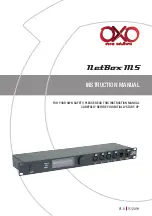
Non-Sound Decoder MX600 - MX634 and Sound Decoder MX640 - MX658 Page 13
3.2
Programm
ing in “Operations Mode” (on-the-main “PoM”)
According to the current NMRA DCC standards it shoul
d only be possible to program and read CV’s
on the main track, but not assign new vehicle addresses. However, certain DCC systems (among
them ZIMO beginning with the system generation MX10/MX32) will allow addresses to be modified on
the main track with the help of bidirectional communication.
All ZIMO decoders are equipped with bidirectional communication (
“RailCom”
) and can therefore
(with a corresponding DCC system such as ZIMO MX31ZL and all devices of the new MX10/MX32
generation) read, program and acknowledge successful CV programming steps in operations mode
(on the main track). This requires RailCom to be activated, which is the case if the following CV’s are
set as:
CV #29, Bit 3 = 1
(usually CV #29 = 14)
AND
CV #28 = 3
This is usually the default setting, except in certain sound projects or OEM CV sets, where they need to
be set first.
3.3
Decoder-ID, Load-Code, Decoder-Type and SW-Version
CV
Designation
Range
Default Description
#250,
#251,
#252,
#253
Decoder-ID
Also identifies decoder
type with
CV #250 = Decoder
type
(see chapter 1)
Read only
-
The decoder ID (serial number) is automatically entered
during production: The first Byte (CV #250) denotes the
decoder type; the three other Bytes contain the serial
number.
The decoder ID is primarily used for automatic address
assignment when an engine is placed on the layout
track (future function) as well is in conjunction with the
“load code” for “coded” sound projects (see CV #260-
263).
CV
Designation
Range
Default Description
#260,
#261,
#262,
#263
“Load code”
for
“coded” sound projects
-
-
New ZIMO sound decoders can be ordered for a small
fee with the “load code” pre-installed, which entitles the
user to install “coded” sound projects of a selected
sound “bundle”.
The load code can also be purchased and installed by
the user at a later date: see
www.zimo.at
or ZIRC.
#8
Manufacturer ID
and
HARD RESET
with CV #8 = 8
or CV #8 = 0
or
Configure decoders
as “C-type” or
“D-type” (MX634 only):
MX634D:
FO3,FO4
= normal outputs
MX634C:
FO3,FO4 = logic level outputs
Activate Special CV Set
Read only
Reading out
the decoder
always shows
“145”, which is
ZIMO’s
assigned
number.
For pseudo
programming
see “Descrip-
tion” column
on the right.
145
( = ZIMO)
Re
ading out this CV always result in “145”
(”10010001”), the number issued for ZIMO by the
NMRA.
This CV is also used to reset various events with the
help of Pseudo-Programming.
Pseudo-Programming means that the entered value is not really stored, but
rather used to start a defined action.
CV #8 = “3”
Converting a MX634D to MX634C
CV #8 = “4”
Converting a MX634C to MX634D
CV #8 = “8”
HARD RESET
(NMRA standard);
all CV’s return to the last active
CV set or sound
project,
or the default values listed in this CV table if
no such set was active before.
CV #8 = “9”
HARD RESET for LGB-MZS operation
(14 speed steps, pulse chain commands).
Further options: see chapter “CV Sets”!
#7
SW-Version Number
Also see CV #65 for
Sub-Version Number
and
special procedures for pro-
gramming with “Lokmaus-2”
and other “low level” sys-
tems
Read only
Pseudo-
programming
see explana-
tion to the right
-
This CV holds the firmware version number currently in
the decoder.
With the help of “Pseudo-programming” it also helps to
program decoders with DCC systems of limited range:
Ones digit = 1: Subsequent programming value + 100
= 2: ... + 200
Tens digit = 1: Subsequent CV number
+ 100
= 2:
… + 200
etc.
= 9:
… + 900
Hundreds digit = 0: Revaluation applies only once
= 1:
… until power-off
#65
SW-
Sub-Version Number
Also see CV #7 for
main version number
Read only
-
This CV indicates a possible sub-version number of a
main version noted in CV #7.
The entire SW version number is thus composed of
CV #7 and #65 (i.e. 28.15).
3.4 The vehicle address(es) in DCC mode
Decoders are usually delivered with default
address 3
(
CV #1 = 3
),
for the DCC as well as the MM
(Märklin Motorola) format. All aspects of operations are possible with this address but it is recom-
mended to change to a different address as soon as possible.
The address space required for DCC exceeds the range of a single CV, up to 10239 in fact. Address-
es higher than 127 are stored in CV #17 and #18. Bit 5 in CV #29 is used to select between the short
address in CV #1 and
the long address in CV’s #17/18.
CV
Designation
Range
Default Description
#28
RailCom Configuration
0 - 3
3
Bit 0 - RailCom Channel 1 (Broadcast)
0 = OFF
1 = ON
Bit 1 - RailCom Channel 2 (Data)
0 = OFF
1 = ON
#29
Basic settings
0 - 63
14 =
0000
1
110
Bit 3 = 1
(“RailCom” is
switched on)
and
Bits
1 & 2 = 1
(28 or 128
speed steps
and DC op-
eration ena-
bled)
Bit 0 - Train direction:
0 = normal, 1 = reversed
Bit 1 - Number of speed steps:
0 = 14, 1 = 28
Bit 2 - DC operation (analog): *)
0 = disabled 1 = enabled
Bit 3 -
RailCom („bidirectional communication“)
0 = deactivated
1 = activated
Bit 4 - Individual speed table:
0 = off, CV # 2, 5 and 6 are active.
1 = on, according to CV ‘s # 67 – 94
Bit 5 - Decoder address:
0 = primary address as per CV #1
1 = ext. address as per CV #17+18














































